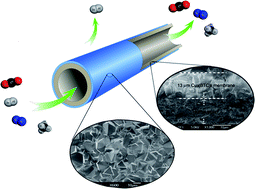High-performance and continuous Cu3(BTC)2 membranes have been successfully fabricated using a secondary growth approach on pre-seeded α-Al2O3 hollow ceramic fibers (HCFs) modified with chitosan. Facile synthesis of Cu3(BTC)2 nanocrystals can be achieved by a modified solvothermal protocol. A stable and homogeneous Cu3(BTC)2 seed precusor obtained with particle size of 300 nm, the size of which is suitable for seeding HCFs without any pore jam of HCFs supports (pore size of 200 nm for HCFs). A new substrate HCFs was introduced as the support of Cu3(BTC)2 membranes. Moreover, for the first time, chitosan is used to improve the binding force between seeds and the support owing to its abundance of both amino and hydroxyl groups. As-prepared Cu3(BTC)2 membrane is studied for hydrogen separation by binary gas permeation of H2/N2, H2/CO2 and H2/CH4. The synthesized membrane shows high H2 selectivity with separation factors of 8.66, 13.56 and 6.19 for the gas mixtures of H2/N2, H2/CO2 and H2/CH4 respectively. A preferred permeance for H2 in the binary gas mixture is obtained in the range of 3.23 × 10−8 to 4.1 × 10−8 mol m−2 s−1 Pa−1 due to the unique properties of the Cu3(BTC)2 MOF material, which is expected in the potential applications of industrial hydrogen recycling.

You have access to this article
 Please wait while we load your content...
Something went wrong. Try again?
Please wait while we load your content...
Something went wrong. Try again?


 Please wait while we load your content...
Please wait while we load your content...